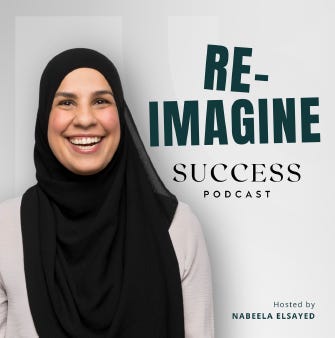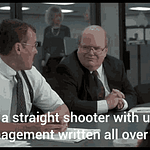"If the thought of preparing drains you, imagine doing the job every day."
-Nabeela Elsayed
This is the third article in my Career Transitions and Decisions Series. In the previous articles, we laid the groundwork with two foundational steps: first, zooming out to gain a big-picture overview of your life and career landscape and second, turning inward for a deep dive into introspection so you could align what you want in life.
If you missed the first two articles in this series, you can listen or read them below:
Now we arrive at the third step in your Career Transition Toolkit: Preparation.
And here, we need to shift our mindset even further, because even the most experienced individuals get this part wrong.
The first step in shifting your mindset is to NOT think of yourself as a job applicant. Instead, you should think of yourself like an entrepreneur pitching a business to investors or someone walking into a bank asking for a $250,000 loan.
Suppose you were asking someone to invest $250,000 in your startup or business. In that case, you’d need to know your market, your competitors, your differentiators, and your go-to-market strategy- and that, folks, is the kind of preparation I coach my clients to have when preparing for an interview. Now you might be thinking, 'That's a bit much.' Yes, it is, but that is how you stand out - you stand out by going above and beyond, by doing things that others wouldn't think of or would be too lazy to do. However, there is another reason why you should prepare as if you are an entrepreneur.
Why? Because when a company hires you, they’re not just giving you a paycheck. They’re buying something from you- the potential value you can add to the company. And to stand out, you need to do more than recite your resume. You need to understand your story- and how that story illustrates the value you will create in the job.
So how do you do that? Let’s break it down:
The 10-Step Investor-Level Interview Preparation Plan
1. Problem Statement: What problems are they hiring you to solve? Research the job description, the company’s recent news, and its industry landscape. What key problem is this role trying to solve? Is it growth? Retention? Innovation? Efficiency? Write down each major challenge the company might be facing- and draw up some high-level solutions and ways you could impact those challenges.
2. Your Unique Solution: Why you? This is your unique value proposition. How have you solved this problem before? What combination of experience, perspective, and personality makes you the best-fit candidate for this role at this moment in this company’s journey? Often the best candidate is the person who brings the right solutions and experience at the time the company needs those solutions and experiences.
3. Market Awareness: Why now? In the real estate market, the saying is: 'location, location, location.' In the job market, the equivalent is: timing, timing, timing. Understand the timing. Are they growing fast? Navigating layoffs? Expanding markets? Rebranding? Could you speak to their context? It shows that you’re not just looking for a job- you understand the moment in time that the company is in.
4. Competitive Landscape: What makes you different? The reality is that the job market is and will likely continue to be flooded with qualified or overly qualified candidates. So what makes you stand out? Think beyond titles and years of experience. Maybe it's how you lead during crises. It could be your cross-industry adaptability. Get specific. What is your unique value proposition? This could be your personal alignment with the mission and vision, the connection to the product/service, your experience, or your education. You need to draw this out and articulate it clearly.
5. Your Operating Model: How do you work? Now folks. I can’t say this bluntly enough- if you show up with stuff like- “I am a servant leader” or “I like to give people space to do their thing” or “I am just passionate about developing people” you will automatically get thrown into a bucket of folks who don’t know themselves well enough to be able to form an original thought. Please don’t say, “Well, I can get impatient and move too fast into action.” You need to possess leadership maturity and emotional intelligence to understand yourself. It’s a determinant of accountability- that you know your internal operating model. If you struggle with talking about yourself- then you’re normal- but that’s not an excuse- do the work.
How do you build teams? How do you make decisions? Handle conflict? What’s your leadership style? Articulate this clearly, not as a buzzword, but as a philosophy, a clear point of view backed up with examples. And for the sake of extreme clarity, let me give you an example:
If I were asked to give an example of my leadership style or approach, I would say:
I thrive on building followership by clarifying a compelling vision and rallying a team around that vision.
A specific example of this was:
Situation:
When I led a $XYZ billion dollar transformation for a large global retailer, I had to align, support, and communicate a compelling narrative that would rally the entire organization around the future.Action:
This involved developing a deep communication approach that included message houses, decision trees, and communications collateral designed to resonate across multiple countries. It also involved identifying and establishing evangelists who could carry the message forward, and continuously aligning both operators and the governance committee around how we were communicating, tracking, and uniting people around the transformation.Result:
We tracked several transformation metrics through regular pulse surveys. One of the key questions was, “I understand why the company is transforming and I trust leadership to lead this transformation.” We consistently scored in the 70–80% range on this measure. In countries or teams where we didn’t meet that benchmark, we implemented hyper-care service—including flying into those locations and being on the ground with the leadership team to reinforce the messaging and address concerns directly.Interesting Fact:
I’m the kind of leader who can directly, honestly communicate across an organization with trust and credibility.
If I know something, I’ll tell you.
If I can’t tell you, I’ll say that too.
And if I don’t know? You’ll hear that straight from me.Learning/Close:
I’ve learned that trust isn’t just earned through results, it’s built in the moments when you choose to be honest, even when it’s uncomfortable. During a massive global transformation, I didn’t just cascade communications from the top. I built a system to ensure that people across continents could hear, feel, and trust the “why” behind every change. And when the trust metrics dropped in a specific region, I didn’t send an email. I got on a plane.
That’s the leadership I practice. That’s the standard I hold.
In the example above, can you feel what I believe in, stand for, how I lead?
Here is where people get stuck: Too many leaders say “I believe in trust, communication, and integrity” — but those are table stakes. You need to tell me how you do those things, and through the example you share, demonstrate the depth behind those values. Okay, enough of that - this is probably an article in its own right. Let’s move to step 6, which is Proof of Concept.
6. Proof of Concept: Where have you done this before? Here’s where your past results come in. Use the SARIL method I demonstrated above: Situation, Action, Result, Interesting Fact, Learning. Write out the relevant examples you have based on the job description of the role. Yes, I literally mean go line by line of the job description and list out your examples.
Make your examples measurable and memorable. Don’t just list tasks, tell stories with outcomes.
7. Personal Brand: Who are you beyond the resume? This is where authenticity matters. What are your core values? What drives you? What kind of legacy do you want to leave in your work? Who are you outside of work? Everyone has a different comfort level with personal disclosure - so know yours and have some personal stories to share if the question arises.
8. Support System: Leadership can be lonely- knowing this and preparing for it shows your leadership expertise and maturity. What kind of support system have you built for yourself? How do you get the support you need? How do you leverage your network, mentors, coaches, peers, or advisors who challenge and support you? It reflects emotional intelligence and a growth mindset.
9. Investment Readiness: Can you articulate ROI? How will hiring you generate results? Whether it’s revenue, retention, engagement, or innovation, connect the dots between your skills and their strategic goals. Make it easy for them to say yes.
10. Mindset and Emotional Readiness: Are you grounded? This is often the missing piece. Career transitions are emotional. They shake our confidence and stir up doubt. But the most compelling candidates have done the inner work. They’re clear on their values, and they lead from a place of purpose, not panic. This will come out in how you carry yourself, your confidence, and your energy.
Final Thoughts: Preparation is a Love Letter to Your Future Self
This kind of preparation takes time. It requires research, doing your homework, honesty, and clarity. If you think you haven’t gone deep enough, you haven’t. If you think you have overdone it, you are probably at the right place. But if you do this work, you’ll not only stand out as a candidate, you’ll step into your next role with the kind of confidence that can’t be faked.
Here’s a simple litmus test:
If you’re not eager or energized to do this level of preparation for a job… It’s probably the wrong job.
Because if you can’t commit a few focused hours — maybe a day or two — to prepare for the opportunity, how are you going to show up for it 40+ hours a week, every week?
Your energy during preparation is revealing.
If your curiosity grows, if your excitement builds as you dig into the company, the problems they’re solving, and how you might fit — that’s a green flag.
But if the more you research, the more drained or disinterested you feel, that’s a signal too.
Should you do this kind of preparation for every job?
No. Only for the ones you actually want.
And if you don’t want it enough to prepare at this level, then maybe you have your answer.
So here’s your call to action:
Get a coach, a mentor, a mirror and rehearse.
Practice your stories using the SARIL method.
Prepare like you're pitching to an investor.
Because, whether you are applying for a job, starting a company which will require investors or taking out a loan, the bottom line is that if the job, the solopreneur or the start-up is what you want, preparing for it is just as much an investment in you as it is in landing the interview.
Until next time, take care of yourselves and those around you.
In Partnership,
Nabeela
🎙️BIG NEWS: The Re-Imagine Success Podcast is (almost) here!
While I’ve quietly been recording my Substack essays as mini-podcast episodes, behind the scenes, I’ve been building something bigger — and I’m thrilled to share it with you finally.
In just a few weeks, I’ll officially launch The Re-Imagine Success Podcast a bold, human, and honest conversation about redefining our relationship with work, success, and achievement.
Next week, I’m flying to Atlanta to kick off the first round of in-person interviews with some incredible thinkers, builders, and brave voices who are challenging the status quo, and I can’t wait to bring you those stories.
I started Re-Imagine Success nearly a year ago as a movement, a vision for work that doesn’t burn us out, betray our values, or trade our well-being for a paycheck. This podcast takes that mission further: tackling the global disengagement crisis, the mental health epidemic, and the unsustainable pace of modern ambition.
This show is for anyone who believes that human sustainability and business success can coexist and that it’s time to build something better.
💥 If that sounds like your kind of conversation, now’s the time: Like, comment, share, and hit follow wherever you get your podcasts. Stay tuned for the official drop.
Join the Group Chat
Starting now, the chat is open to all subscribers, free and paid.
If you’ve been reading quietly, this is your cue to join the conversation. Bring your thoughts, your questions, your uncertainty.
Let’s make this space one where we can wrestle with significant shifts together with honesty, curiosity, and a bit of hope. I’d genuinely love to see you there.’

















